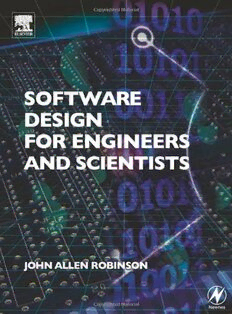Download Software design for engineers and scientists PDF Free - Full Version
Download Software design for engineers and scientists by John Allen Robinson in PDF format completely FREE. No registration required, no payment needed. Get instant access to this valuable resource on PDFdrive.to!
About Software design for engineers and scientists
Software Design for Engineers and Scientists integrates three core areas of computing: . Software engineering - including both traditional methods and the insights of 'extreme programming' . Program design - including the analysis of data structures and algorithms . Practical object-oriented programming Without assuming prior knowledge of any particular programming language, and avoiding the need for students to learn from separate, specialised Computer Science texts, John Robinson takes the reader from small-scale programing to competence in large software projects, all within one volume. Copious examples and case studies are provided in C++ and students can access complementary examples in Java on an accompanying website. The book is especially suitable for undergraduates in the natural sciences and all branches of engineering who have some knowledge of computing basics, and now need to understand and apply software design to tasks like data analysis, simulation, signal processing or visualisation. John Robinson introduces both software theory and its application to problem solving using a range of design principles, applied to the creation of medium-sized systems, providing key methods and tools for designing reliable, efficient, maintainable programs. The case studies are presented within scientific contexts to illustrate all aspects of the design process, allowing students to relate theory to real-world applications. All listings are available on this book's companion website. · Core computing topics - usually found in separate specialised texts - presented to meet the specific requirements of science and engineering students · Demonstrates good practice through applications, case studies and worked examples based in real-world contexts · Additional website resources are available, including useful links and further worked examples using Java
Detailed Information
| Author: | John Allen Robinson |
|---|---|
| Publication Year: | 2004 |
| ISBN: | 750660805 |
| Pages: | 429 |
| Language: | English |
| File Size: | 2.013 |
| Format: | |
| Price: | FREE |
Safe & Secure Download - No registration required
Why Choose PDFdrive for Your Free Software design for engineers and scientists Download?
- 100% Free: No hidden fees or subscriptions required for one book every day.
- No Registration: Immediate access is available without creating accounts for one book every day.
- Safe and Secure: Clean downloads without malware or viruses
- Multiple Formats: PDF, MOBI, Mpub,... optimized for all devices
- Educational Resource: Supporting knowledge sharing and learning
Frequently Asked Questions
Is it really free to download Software design for engineers and scientists PDF?
Yes, on https://PDFdrive.to you can download Software design for engineers and scientists by John Allen Robinson completely free. We don't require any payment, subscription, or registration to access this PDF file. For 3 books every day.
How can I read Software design for engineers and scientists on my mobile device?
After downloading Software design for engineers and scientists PDF, you can open it with any PDF reader app on your phone or tablet. We recommend using Adobe Acrobat Reader, Apple Books, or Google Play Books for the best reading experience.
Is this the full version of Software design for engineers and scientists?
Yes, this is the complete PDF version of Software design for engineers and scientists by John Allen Robinson. You will be able to read the entire content as in the printed version without missing any pages.
Is it legal to download Software design for engineers and scientists PDF for free?
https://PDFdrive.to provides links to free educational resources available online. We do not store any files on our servers. Please be aware of copyright laws in your country before downloading.
The materials shared are intended for research, educational, and personal use in accordance with fair use principles.

